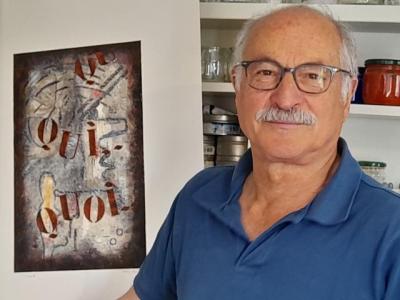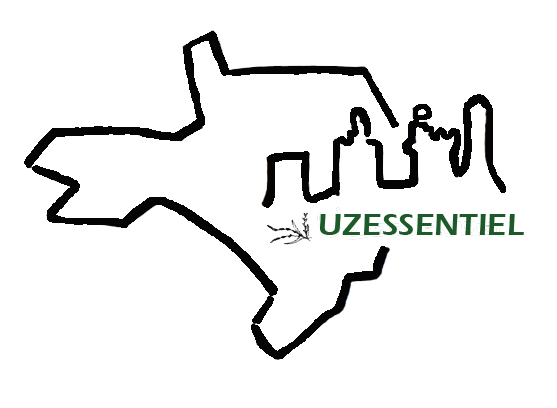Sculpture, painting, engraving, Three artists, three stories
- Par nbesse
- Le 17/09/2024
- Dans Interviews and portraits
FR - When the Domaine de Malaïgue becomes a theatre stage and art gallery while hosting a book signing, it is always with the promise to be a good time for meeting challenging people and art.
It also makes us want to find out more about the careers of the exposed artists taking part in this multi-faceted exhibition, who are coming together in an art-filled rural setting.
Three forms of artistic creation, three ways of looking at the world and, in particular, at the nature that surrounds us....
MEETING
Let us introduce you to Suzie Bouët (@suziesiouz), a master of cut-out iron sculptures, a veritable aerial metal lace.
The artist ‘shapes emptiness to reveal fullness, moving from the harshness of the metal to the lightness and delicacy of the work’.
 You are present alongside Laurent Gremillet and Samy Abesdris. How do their artistic approaches complement yours?
You are present alongside Laurent Gremillet and Samy Abesdris. How do their artistic approaches complement yours?
Each of us brings its own personal touch on how to understand the world.
I think that each of us is an explorer in our own way. Each of us comes to question our link with the living world with our own universe and our own sensibility...
For how long have you been working with metal? Have you always been an artist? What training have you had?
I discovered plasma metal cutting quite recently, in 2021, when I was looking at the sculptures of an artist from Uzès, and I was immediately attracted by the results that this tool offered.
As for drawing, it's been with me since childhood. It's what led me to take a course at the Beaux-Arts in Nîmes, which I completed in 2010.
Perhaps that's also the link between the 3 of us, our years spent at the Beaux-Arts in different towns and at different times.
Although discovering ironwork and welding appealed to me, I didn't go very far in this field, although I've always collected and kept rusty metal with the idea of giving it a second life one day.
Then a desire to travel, two children to bring up... made me refocus my energy while keeping creation in the back of my mind. It was mainly during the last 4 years that the impetus came back when a friend asked me to illustrate his poems. Another great collaboration.

Your themes are reminiscent of human beings and communion with nature...
My recurring themes are very human. My sculptures metaphorically evoke the dialogue between light and shadow that we all carry within us. It's my personal and original way of bringing softness and serenity to complexity. For a whole period, I was drawing a human figure in a natural environment, in peace.
But I'm not surprised by this tendency. As I come from a family of organic market gardeners, I've always had my feet firmly on the ground, and I've always questioned the way in which humans interact with living things.
Does cutting metal remind you of cutting paper, which you also practise? But the demands are quite different I guess... Are the themes you tackle in paper the same as those that inspire your metal creations?
Between iron and paper, the approach to drawing remains the same: you always have to create closed lines. In a word, it has to ‘hold together’.
But whereas in one case, the creation, subject to the challenge and uncertainty of the result involves my whole body, in the other case, the paper is cut using a laser, which means that it can be reproduced, and so there's a sort of routine.
My other projects? Well, that's a tough one! Continuing to let my imagination run wild I think...
Now we come to Laurent Grémillet (@laurent.gremillet), whose artistic approach to Indian ink drawings is ‘based on the interaction of his memories and an intimate exploration of his memory and emotions’. An aerial journey, where the fine pen glides over the paper to pay homage to nature...

You describe yourself as a non-regular, unconventional artist.
Ephemeral outdoor installations, among other projects lead you to joint, plural exhibitions, as is the case at the Domaine Malaïgue, where you are exhibiting 12 inks.
Above all, you love sharing and interacting with others, in the broadest sense of the term. Has it always been this way?
Yes, exactly. Interaction and sharing are the most important aspects of my art, it seems to me.
What's more, exhibiting ephemeral installations outdoors over 1 or 2 days creates a different relationship with art. It's freer and more open to everyone. What I personally took away from it was the fact that there was no longer any relationship between possession and ownership - there was no value! Only an ephemeral experience, for the public only.
At the Domaine de Malaïgue, these 12 inks are like a parenthesis, but I also intend to add an ephemeral installation in a vat, to establish a sort of ephemeral dialogue with the previous artist Tamara Morisset, who came this summer to exhibit her installations.

What was your artistic training? Art school or self-taught like many artists, which adds a very personal touch to their work?
In reality, it all started with a BEP Agricole in horticulture and landscape techniques. As i totally committed to the job, my architecture teacher suggested that I continue my studies at a garden architecture school. At the same time, after discovering Giovanni Battista Piranesi's famous ‘Carceri’ engravings (Imaginary prisons), I joined an engraving workshop and took the competitive examination for the Ecole des Beaux-Arts de Paris in the engraving section, from which I graduated.
Through the intermediary of my violinist friend Darío Perez and his father, the kinetic artist Darío Pérez-Flores, I had the opportunity to join the Paris studio of the Venezuelan kinetic artist Carlos Cruz-Diez as his assistant. It was a major encounter, rich and decisive for my pictorial dialectic.
As an art director in advertising for many years, I found it an inexhaustible and stimulating source of creation.
Today, I divide my time between my work in the vineyards at Domaine de Malaïgue, my plant creations, learning to play the didgeridoo, an instrument of arboreal origin, designing ephemeral installations and... a few ‘inky interludes’.
In the latter, there's a constant reference to nature and plants... Where do you draw your inspiration from? What media are best suited to your creations?
My artistic approach is based on creating interactions of memories, an intimate exploration of memory and emotion. The project exhibited at the Domaine de Malaïgue consists of 12 unique works in Indian ink and pen, a return to my first artistic love, a tribute to my past as an engraver and the deep blacks that marked this practice.
These creations are inspired by several personal and artistic sources. First of all, there's botany, which gives my work a natural, living foundation. Then there are my childhood memories of reading Jules Verne's Journey to the Centre of the Earth, whose black and white illustrations fascinated and influenced me deeply. Finally, my adolescence was marked by moments of reflection, particularly after hearing Charlie Chaplin's speech on humanity at the end of the film The Great Dictator, especially the end of his speech to Hannah.
All these diverse influences meet and respond to each other in these 12 inks, creating visual dialogues that question our relationship with time, memory once again and the human experience. Each piece is a parenthesis, a window opening onto a world of contrasts and nuances, light and shadow, and spaces for contemplation.
Apart from your inks, what other techniques do you use, and in what other areas do you practise your artistic talents?
I don't have any particular technique; it's more a question of adapting to my inspirations. In recent years, my ephemeral installations have been outdoors, using very different techniques.
Do you have any upcoming projects?
There will certainly be many, but they'll come at a time when we're not expecting them!
Finally, we'd like to give the floor to Samy Abesdris (@samy_graveur) whose paintings and engravings, like ‘his Nature Forte series, are a reminder that for a very long time humans have held a position of domination over nature and have granted themselves a kind of unrestricted right to draw’.

You describe yourself as an ‘explorer’. How does that define your work?
My creations are always based on themes that I've been working on for several years.
For each one, I like to question the medium, the approach and the production technique. In my opinion, to link an artist to a style is unfortunately, if not unfairly, to reduce an entire life devoted to creation.
Painting, printmaking... You have chosen quite similar artistic paths. How did you train in these arts and techniques?
Like all artists, I started by drawing. Then the need for colour came along with painting. As for engraving, it was at the Ecole du Louvre in Paris that I really discovered it and it was at the PASNIC engraving workshop, still in Paris, that I perfected my skills. Now I combine them freely to open up even more creative possibilities.
You believe, as in the Nature Forte series mentioned above, that the role of nature is to remind us that the world must be shared... Has this naturalistic commitment always been at the heart of your work?
No, that's not always the case... Like everyone else, it took me time to develop my sensitivity to this issue. My intellectual activism has essentially been focused on human beings, forgetting about nature. I hope it's not too late.
 Between painting and printmaking, is there one art form that is more powerful than the other in getting your message across?
Between painting and printmaking, is there one art form that is more powerful than the other in getting your message across?
They are different and complementary. Painting is strong and powerful meanwhile printmaking is fine and subtle. However, a work must be able to suggest something and leave it open to interpretation.
You exhibit at the Domaine de Malaïgue on a collegiate basis. Is this always the case, how does joining forces with other artists prove relevant, complementary perhaps?
I rarely take part in group exhibitions. But when I do, like the one we're sharing at the Domaine with Suzie Bouët and Laurent Grémillet, each of us tells a story in our own way. It's nice to know that the public will be invited to interpret the works and identify the links that bring them together.
What are your next projects? A new series of prints perhaps?
My short-term artistic project? Well... to complete and exhibit in the near future a series of engravings entitled ‘Les Jacqueries’ (French popular revolts) on the theme of popular social and societal uprisings.
Many thanks to Suzie Bouët, Laurent Grémillet and Samy Abesdris for their collaboration on this article.
The right address: Find the artists on Instagram Suzie Bouët @suziesiouz, Laurent Grémillet @laurent.gremillet, Samy Abesdris @samy_graveur.






